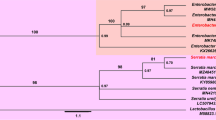Abstract
Experimental infections of Lymnaea truncatula by Fasciola hepatica (one, two, or three miracidia per snail) were carried out under laboratory conditions to analyze the oviposition of infected snails and determine the characteristics of their egg masses. In the infected snails from the three groups, egg-laying steadily decreased until week 4 postexposure and stopped afterward until the end of the experiment, except for the cercaria-shedding snails from the one-miracidium group, for which low numbers of egg masses were noted between weeks 9 and 12. In uninfected snails the number of egg masses decreased until week 4 and remained low during subsequent weeks. At weeks 11 and 12 postexposure the natality rate was 98.9% in controls, 56% in the cercaria-shedding snails from the one-miracidium group, and 59.2–68.5% in uninfected snails. In the cercaria-shedding snails from the one-miracidium group the restoration of reproduction activity after week 8 may be explained by a lower parasite burden in these snails than in those from the two- and three-miracidium groups.
Similar content being viewed by others
Author information
Authors and Affiliations
Additional information
Received: 25 September 1998 / Accepted: 15 December 1998
Rights and permissions
About this article
Cite this article
Dreyfuss, G., Rondelaud, D. & Vareille-Morel, C. Oviposition of Lymnaea truncatula infected by Fasciola hepatica under experimental conditions. Parasitol Res 85, 589–593 (1999). https://doi.org/10.1007/s004360050599
Issue Date:
DOI: https://doi.org/10.1007/s004360050599




